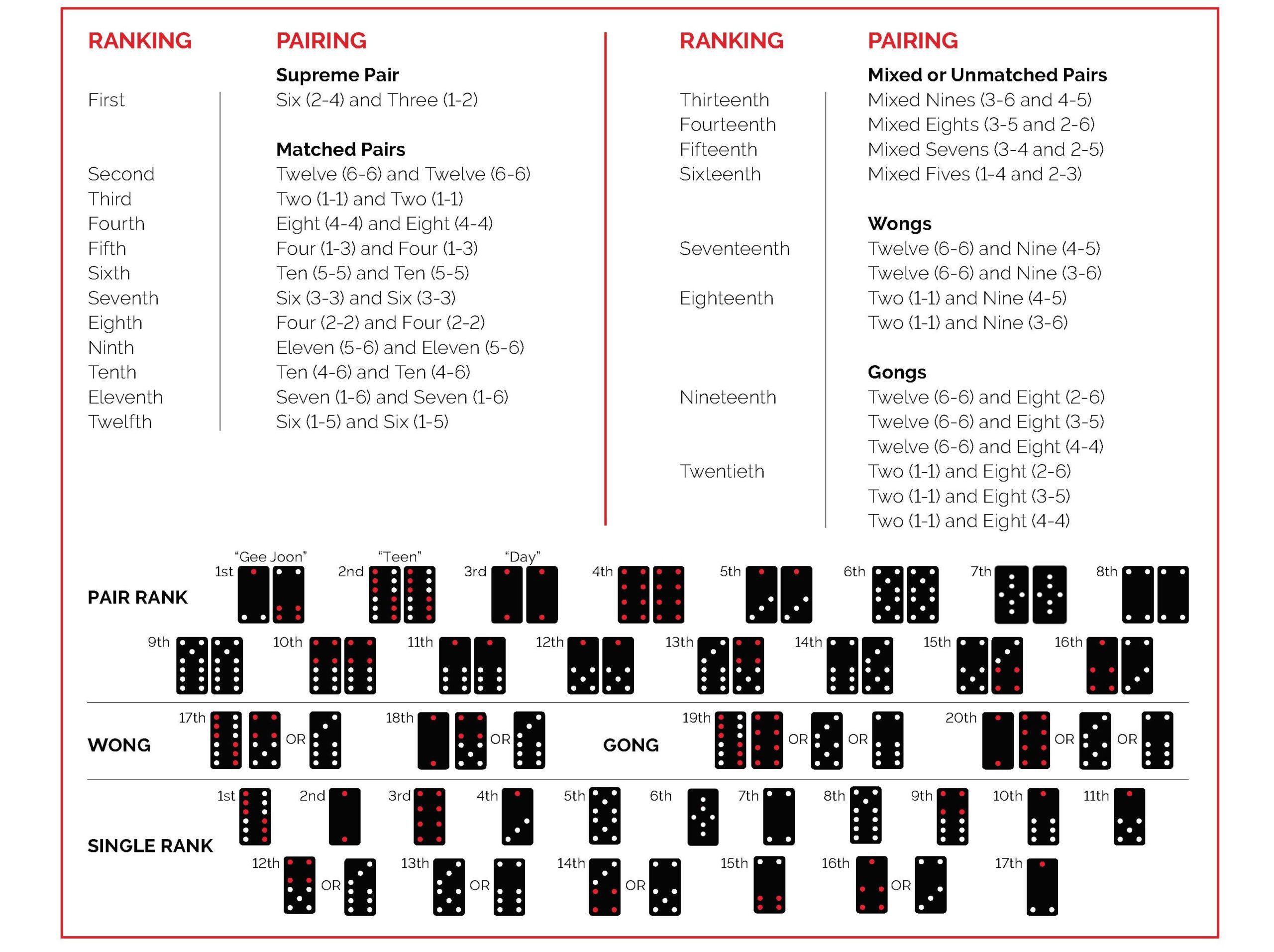How to Play Pai Gow Tiles
Pai Gow is an ancient Chinese betting game played with Chinese dominoes also called tiles.
The object of the game is to beat the Banker. The Banker can be the Dealer or any Player. Any Player who wishes to Bank must accept responsibility for all wagers made during that round of play. The Banking option will be offered to each Player, in turn, rotating in a counterclockwise direction. The Banking Player must have enough chips to cover all wagers placed in that round and must have wagered in the previous round that the Dealer acted as Banker. No Player will be required to accept the Bank and the Dealer will act as Banker when all Players decline.
Pai Gow is played with a set of 32 Chinese tiles, which form 16 permissible pairs. A hand with any permissible pair is ranked higher than a hand that does not contain a pair. The highest ranking hand is the Supreme Pair, followed by Matched Pairs, and Unmatched or Mixed Pairs. The next highest-ranking hands are special combinations known as Wongs and Gongs. Hands consisting of Wongs or Gongs are ranked lower than Pairs.
Wongs are formed with the highest-ranking single tile, 12, and either 9 (Teen Wong) or the second-highest tile, 2, and either 9. Please refer to the Single Tile Ranking Chart.
Gongs are formed with the highest-ranking single tile, 12, and any 8 (Teen Gong) or the second-highest tile, 2, and any 8 (Day Gong).
The next highest-ranking hands are numeric value hands, the highest of which is 9. Hands that do not contain pairs have numeric values. Each tile has a numeric value and a symbolic ranking.
To find the numeric value, add the spots on each tile. The total will never be higher than 9 because only the last digit in the total number of spots is used. To find the ranking of each tile and each permissible pair, refer to the ranking charts. Two tiles will combine to form a hand. Add the total number of spots contained on the two tiles. If the numeric total of the spots is a two-digit number, the left digit is discarded and the right digit is the value of the hand.
*When two hands have the same numeric value, the ranking will determine the winner. To determine which hand is higher, find the highest-ranked tile in each hand and compare them. When two hands have the same numeric value and identical high tiles, it is called a “Copy Hand.” The Bank wins all Copy Hands.
**When two hands have the same numeric value of zero, they are considered equally bad, regardless of the high tile and the Bank will win all zero tiles. When the two tiles that form the highest-ranking hand (the Supreme Pair) are used separately, the numeric value is interchangeable. The 3 can be counted as 6 and the 6 can be counted as 3. They lose their highest pair rank and become low-ranking tiles (fifteenth and seventeenth on the
Single Tile Ranking Chart).
The Dealer will shuffle or “wash” the tiles and stack them into eight stacks of four tiles each. To begin the game, the Players will place their wagers before the Dealer announces, “No more bets.” Three dice, contained inside the Pai Gow shaker, will be used to determine the starting position for dealing the tiles. The Dealer or Banker will shake the Pai Gow shaker at least three times. The Dealer will uncover the dice and announce the total. The count will begin with the Dealer or the Banking Player and continue with each betting position in a counterclockwise direction until it matches the total on the dice. That position will receive the first stack of tiles.
After the tiles have been delivered, each Player will “set” their tiles into two hands of two tiles each; a High Hand and a Low Hand. The Players will place their hands face down behind the betting area, separated into two distinct hands. Once the Player has set his tiles face down on the layout he or she will not be permitted to touch the tiles again.
Each Player at the table is responsible for setting his or her own hands and no other person except the Dealer may touch the tiles of that player. Each Player is required to keep the four tiles in full view of the Dealer at all times.
After the Players have set their hands, the Dealer will arrange the tiles into a High and Low Hand. The Dealer must set their hand by using a set of rules known as “the House Way.” Players may request assistance from the Dealer in setting their hands according to House Ways.
The Dealer will compare the Low Hand of the Bank (Dealer/Bank or Player/Bank) to the Low Hand of the Players and the High Hand of the Bank to the High Hand of the Players and announce if the wager of that Player wins, loses, or is a tie, which is known as a Push.
In order for the Player to win, their Low Hand and High Hand must be higher in rank than the Low Hand and High Hand of the Bank. In the case of zero tiles, the Bank wins. The winning wagers will be paid at even money less a 5% commission. The Dealer will collect the commission when the winning wager is paid.
YOU MIGHT ALSO LIKE: How to Play Pai Gow Poker
If either hand of the Player is higher than either hand of the Bank and the other is not, the hand will be considered a Push and no is money won or lost. No commission will be charged on Pushes and the Player will be allowed to change or remove his bet before the start of the next hand.
A Player may bank the game if certain conditions are met. The Player placed a wager against the dealer during the last round of play in which there was no Player banking the game. The Player has sufficient gaming chips on the table to cover all of the wagers placed by other Players at the table for that round of play. The Player may bank for up to the amount they had wagered during the previous round.
Any Player wishing to join in a partnership with the house may do so by requesting Co-Banking. Co-Banking occurs when the requesting Player and the Dealer act as the Banker on a fifty-fifty basis. When Co-Banking is in effect, the Dealer handles the Bank hand, setting it according to House Ways.
All wagers at Pai Gow shall be made by placing gaming chips or match play coupons on the appropriate betting area of the layout, before the Dealer has announced “No more bets,” at which time no wager may be increased or withdrawn.
No verbal wagers accompanied by cash are accepted.
Only Players who are seated at the Pai Gow table may place a wager at the game. Once a Player has placed a wager and received tiles, they must remain seated until the completion of the round of play.
Pai Gow Tile Rankings
When comparing high hands or low hands to determine the higher ranking hand, the determination is first based upon the rank of any permissible pair of tiles which are contained in the hands. A hand with a permissible pair of tiles ranks higher than a hand which does not contain any permissible pair. The permissible pairs of tiles and their rank, with the Supreme Pair being the highest or first ranking pair, are as follows:











